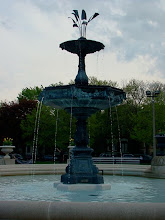href="https://blogger.googleusercontent.com/img/b/R29vZ2xl/AVvXsEgKvn4UgWUHRFIu0bTJUeXx6i33d8ojQMB1uWVz0KJ-E-eaJMPmTnxHBagh35nzucsBOevwWTvyncO90lsQ5vxIGR1ryj_9F3f2kFi7r9_8ZCeJAvpb4gU62bul4Bst9jYGEoqhAMpyhvQ/s1600-h/DSC00248.JPG">



Just when I think I'm not sure about Michael Moore-- his motivations, his skewing of facts to heighten stories, his profiting so extremely off being somewhat of a red carpet gadfly-- he does something totally awesome like make his latest movie, Capitalism: A Love Story, free tonight for those living in select cities like Chicago that have been hit especially hard by the downturn in the economy.
In a way, it's odd that I'm about to start my day by going to a trunk show downtown for a designer specializing in fashions for the fuller figured woman of affluence, and, after a few stops in-between, end the day by seeing a free movie by our nation's leading provocateur.
Both the designer, and Michael Moore serve underserved people, and they are shedding a light on a different America not seen in the mainstream despite the fact that 60% of American women are plus sized, and about one out of every 10 Americans do not have a full-time job.
As for Michael Moore, I too was born in Flint, Michigan, though my family moved from Flint shortly thereafter, so I have no memory of the city MM made famous via Roger & Me, yet many years ago I chatted with him on the phone, as well as emailed him an idea for a movie that I thought he should explore, about a small town in Illinois that ran a factory that had employed three generations of townspeople, and was closing because it appeared to be cheaper for Johnson & Johnson to manufacture its feminine maxi-pads in Canada vs. the midwest. He thought I should explore it further on my own, and while I visited the town for a day, hung out in its library reading newspaper clippings about the factory, and interviewed a bunch of people at a bar, and a woman from the historical society, at the time I had too much other stuff going on, and didn't end up trying to write a story. Now that I have a bit more time on my hands I might go see what has happened to this town over the past 10 years. It was around 1999 when the factory was closing. If I recall correctly, the factory had employed about 10 to 12% of the small town, thus making it an interesting study because close to that same percentage of Americans are not working today. Hopefully the economy will be vastly improve 10 years from now, but curiosity is already leading me to that town again, to see what it looks like now, 10 years after the maxipad factory shut its doors.

No comments:
Post a Comment